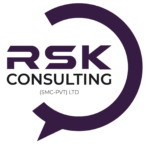CMMI Appraisal
CMMI
The Capability Maturity Model Integration (CMMI)® is a proven set of global best practices that drives business performance through building and benchmarking key capabilities.
Originally created for the U.S. Department of Defense to assess the quality and capability of their software contractors, CMMI models have expanded beyond software engineering to help any organization in any industry build, improve, and measure their capabilities and improve performance.
For over 25 years, high-performing organizations around the world have achieved demonstrable, sustainable business results with CMMI. CMMI best practices focus on what needs to be done to improve performance and align operations to business goals. Designed to be understandable, accessible, flexible, and integrate with other methodologies such as agile, CMMI models help organizations understand their current level of capability and performance and offer a guide to optimize business results.
As stated by the CMMI Institute, “CMMI’s performance improvement model has helped thousands of globally recognized companies over the last 25+ years—including many Fortune 500 organizations. CMMI V2.0 adds to the legacy as a trusted source of proven best practices. In addition, through the new online platform, V2.0 will be continuously updated to reflect changing needs, helping businesses perform their best long into the future.” The figure below shows the performance results many organizations are experiencing through the adoptions of CMMI V 2.0

CMMI V2.0
 Ensuring Quality
Ensuring Quality Selecting & Managing Supplier
Selecting & Managing Supplier Managing the Workforce
Managing the Workforce Improving Performance
Improving Performance Engineering & Developing Products
Engineering & Developing Products Planning & Managing Work
Planning & Managing Work Supporting Implementation
Supporting Implementation Improving Performance
Improving Performance Delivering & Managing Services
Delivering & Managing Services Managing Business Resilience
Managing Business Resilience Sustaining Habit & Persistence
Sustaining Habit & PersistenceBreaking Down CMMI V2.0
CMMI version 2.0 is one model with multiple customized views that apply to different business environments, enabling organizations to create a view of the model that meets their specific performance improvement needs. The different views of the CMMI 2.0 model include CMMI for Development (DEV), CMMI for Services (SVC), and CMMI for Supplier Management. Each view is used to improve different areas. CMMI Development improves an organization’s capability to develop quality products and services that meet the needs of customers and end users. CMMI Services improves an organization’s capability to efficiently and effectively deliver quality service offerings that meet market and customer needs. CMMI Supplier Management improves an organization’s capability to identify and manage suppliers and vendors in a way that maximizes supply chain efficiency and reduces risk.
Changes in CMMI V2.0
Key Differences between CMMI V1.3 and CMMI V2.0
Is your organization considering transitioning from CMMI V1.3 and CMMI V2.0 to better measure its capabilities, but is seeking further clarity about the main differences between the two? See some of the key features of both below, and for more information on CMMI V2.0.
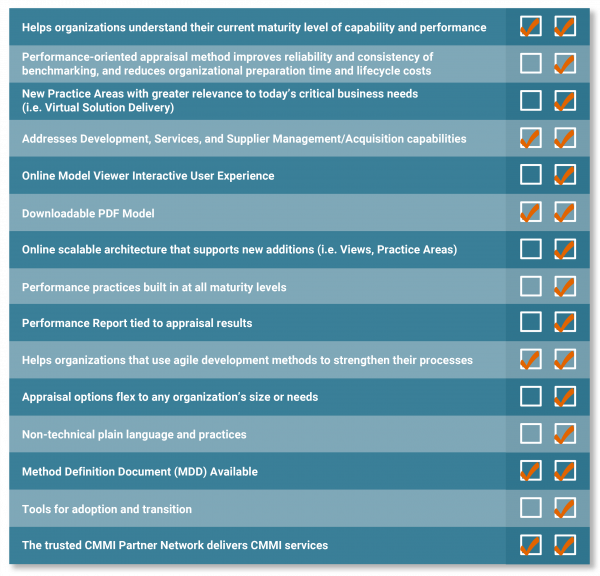
Key CMMI V2.0 Improvements
Improve Business Performance
Business goals are tied directly to operations in order to drive measurable, improved performance against time, quality, budget, customer satisfaction and other key drivers.
Leverage Current Best Practices
CMMI V2.0 is a trusted source of proven best practices that will be continuously updated to reflect changing business needs on the new online platform.
Build Agile Resiliency and Scale
Direct guidance on how to strengthen agile with Scrum project processes with a focus on performance.
Increase Value of Benchmarking
New performance-oriented appraisal method improves reliability and consistency of benchmarks while reducing preparation time and lifecycle costs.
Accelerate Adoption
Online access and adoption guidance make the benefits of CMMI more accessible than ever.
Integrated Product Suite
CMMI Appraisals V2.0 is an integrated product suite consisting of 5 components that, when used together, provide a clear and proven path to achieving your business objectives.
Training & Certification
Updated training has modular components with virtual and in-person options. The training is more learning objective oriented.
Appraisal Method
A new appraisal method helps to increase reliability while reducing overall cost.
Model
Clear pathway to performance improvement. Simplified for accelerated adoption.
Adoption Guidance
Guidance for a smooth transition from CMMI V1.3 to V2.0 and for new adopters helps users get started with CMMI V2.0.
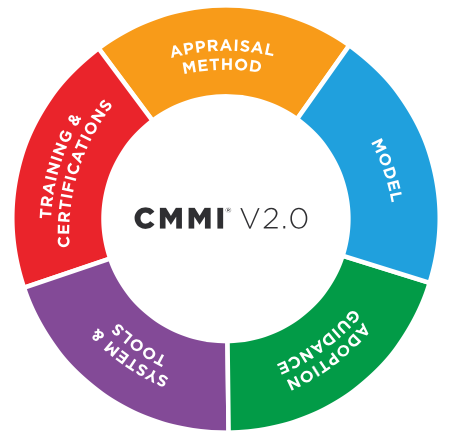
Systems & Tools
Redesigned system to access online models and resources.
Why Build Capability?
Organizations know their capabilities see results:
 Decreased risks.
Decreased risks.
 Increased productivity.
Increased productivity.
 Increased Customer Satisfaction.
Increased Customer Satisfaction.
 Increased profit through improved quality and less rework.
Increased profit through improved quality and less rework.
 Increased probability of capturing new and repeat business.
Increased probability of capturing new and repeat business.
All organizations have capabilities. Through our many years of experience at Kreative, we have realized what many organizations don’t have is a process by which they can measure their different capabilities against best practices and pinpoint which ones are driving higher performance. The figure below by the CMMI Institute illustrates some of the most common gaps in organization’s capabilities.

Driving Performance Through Capability
CMMI and its Maturity Levels Explained
Unless your organization is trying to get to a certain level to qualify for a contract that specifies what they require, then the choice of measuring progress using maturity levels or capability levels is up to you. The difference in measuring progress is that capability levels measure process improvement in individual process areas, while maturity levels measure process improvement according to the scope of the organization that was appraised (e.g. a project, a department, a division).
MATURITY LEVELS
Maturity levels represent a staged path for an organization’s performance and process improvement efforts based on predefined sets of practice areas. Within each maturity level, the predefined set of PA’s also provide a path to performance improvement. Each maturity level builds on the previous maturity levels by adding new functionality or rigor.

Maturity Level 0: Incomplete
Ad hoc and unknown. Work may or may not get completed.

Maturity Level 1: Initial
Unpredictable and reactive. Work gets completed but is often delayed and over budget.

Maturity Level 2: Managed
Managed on the project level. Projects are planned, performed, measured, and controlled.

Maturity Level 3: Defined
Proactive, rather than reactive. Organization-wide standards provide guidance across projects, programs, and portfolios.
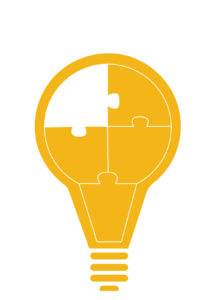
Maturity Level 4: Quantitatively Managed
Measured and controlled. Organization is data-driven with quantitative performance improvement objectives that are predictable and align to meet the needs of internal and external stakeholders.
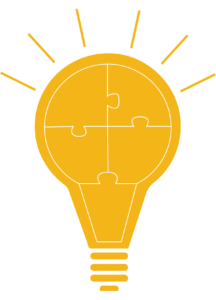
Maturity Level 5: Optimizing
Stable and flexible. Organization is focused on continuous improvement and is built to pivot and respond to opportunity and change. The organization’s stability provides a platform for agility and innovation.
CMMI V2.0 Appraisal Method
The CMMI V2.0 Appraisal Method Definition Document describes four types of CMMI V2.0 Appraisals: Benchmark, Sustainment, Evaluation, and Action Plan Reappraisal. Each type is designed to result in findings that describe the strengths and weaknesses of your organization’s processes based on CMMI best practices. Familiarity with each type will help you make better decisions about which appraisal is right for your organization to meet business objectives and foster process improvement. Below outlines the different types of CMMI V2.0 Appraisals:
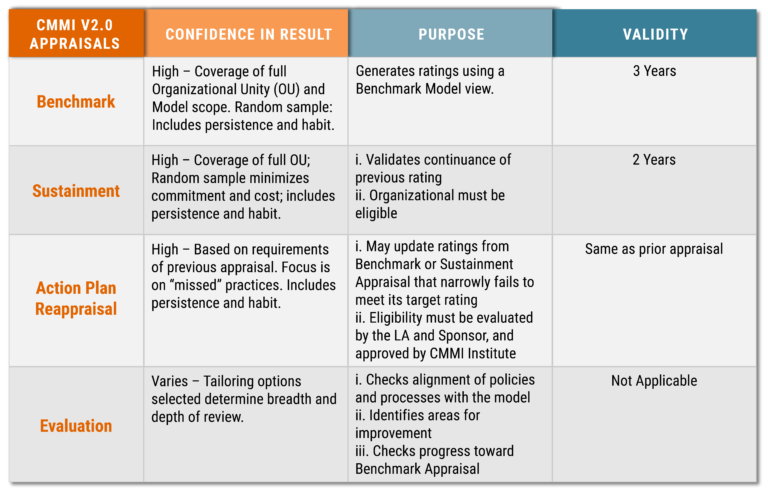
Benchmark Appraisal
Benchmark Capability and Performance is one of the many benefits to the new CMMI V2.0 model. The new performance-oriented appraisal method improves the reliability and consistency of benchmarking while reducing preparation time and life-cycle costs. The benchmark appraisal allows you to identify opportunities for organizations to improve how they implement processes and their overall business performance. The Benchmark covers the full Organizational Unit (OU) and Model scope. It consists of a random sample among the projects. The Benchmark requires a high commitment of people, and time. It is valid for 3 years.

Appraisal Team/ATM Member
An Appraisal Team, made up of Appraisal Team members (ATM), is the group of individuals that will participate and aid in the appraisal process during a
Benchmark Appraisal. Every ATM must follow the V2.0 Appraisal Team Member Participation Policy outlined below.
-
Potential ATMs must possess at least 3 years of experience performing the type of work being appraised. (An appraiser may accept one team member with less than 3 years’ experience with rationale recorded in the appraisal plan.)
-
Potential ATMs must have taken an official introduction course or upgrade course for CMMI V2.0. These courses will be one of the following:
-
Foundations of Capability AND a View-specific course (i.e. Building Development Excellence, Building Service Excellence, or Building Supplier Management Excellence for an ATM who would like to serve on a CMMI V2.0 appraisal)
-
CMMI V2.0 Upgrade Training (completed through either an In-Person Partner-Led Section OR eLearning offering).
-
-
All ATMs must have an be active Certified CMMI Associate (V2.0). This credential is achieved by passing the Certified CMMI Associate Exam (V2.0). The Certified CMMI Associate credential is valid for three years from the date of passing the exam. The Certified CMMI Associate Exam is assigned to any individual who is registered for Foundations of Capability or CMMI V2.0 Upgrade Training (Partner-Led or eLearning).
At Kreative, we know just how important it is to have certified audit team members that understand your organization, which is why we encourage our own employees to become ATM certified! We are proud to announce that our employees have years of experience as appraisal team members, contributing to our 100% success rate and high level of customer satisfaction. If you need experienced and certified ATM members, contact Kreative!
PARS website
ISACA’s CMMI Published Appraisal Results System (PARS) is a website where organizations can choose to publish the results of their Benchmark or Sustainment appraisal types. This website publishes the CMMI level achieved by organizations that have been appraised using the Benchmark or Sustainment appraisal types. Evaluation appraisal results are not currently published.
With permission, your appraisal results can be shared so that others can see your achievements. By knowing the appraisal results of prospective suppliers and business partners, you can make better decisions about creating business relationships with them. The appraisal results of competitors help you to understand them and compete more effectively.
Join over 100+ successful companies club.
Join over 100+ companies using our unique go-to-market approach to a sustainable competitive advantage.
